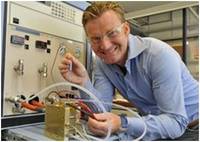"In the field of Electromobility mainly research on lithium-ion battery technology has been promoted in the past years. But the limits of this technology become more and more obvious. ", states Peter Strasser, a professor for Technical Chemistry at TU Berlin and member of UniCat.
"Thereby the idea of hydrogen based E-mobility slowly returns to the center of attention. In this technology a fuel cell, acting as an energy converter, feeds the electrical motor. Conceivably could be also the use of a fuel cell as a kind of ‘range extender’ - thus an additional device to increase the cruising range – interacting with a Li-Battery. "
His research team makes part of an Excellence Project of the U.S. Department of Energy (DoE), which researches new nano-structured materials. The researchers want to make the catalytic conversion of hydrogen and oxygen into usable electricity in fuel cells more efficient and less costly. The U.S. Department approved now a total of 5.3 million U.S. dollars for the next three years, of which approximately $ 1.5 million will go to the TU Berlin.
The TU team works closely together with two industrial partners and with three academic institutions, with the Massachusetts Institute of Technology (MIT), the Northeastern University and the George Washington University.
Hydrogen fuel cells use molecular hydrogen to store energy. Their density is almost 200 times higher than that one of a Li-ion battery. In the drive of the hydrogen-based fuel cell the chemical energy of hydrogen is converted into electrical energy. Although the practical conversion efficiency currently is only about 50 percent, an electric car requires only about six kilograms of hydrogen for a 450 km range, and refueling takes only six minutes. A typical Li-ion battery, however, weighs at least 200 kilograms, takes six to nine hours for loading and extends for only for a range of 200 km. In addition, if solely battery powered, the vehicle has to be air-conditioned electrically because of the missing rejected heat. This again can reduce the range significantly.
"Even comparing the costs, the fuel cell scores much better," declared Strasser. "Li-ion batteries cost currently about 300 € per kilowatt hour. In a typical-sized vehicle a range of 200 kilometers charges with about 12 000 €. Comparable performance characteristics with a fuel cell of the latest generation cost around 5000 €, in which the range naturally depends on the size of the tank, not of the fuel cell." What makes fuel cell expensive is, about all, the precious metal platinum, used as a catalyst in nanostructured form. Peter Strasser and his colleagues in the joint project want to reduce exactly this part of the costs. So far, 0.8 grams of platinum were needed per kilowatt. The scientists want to reduce this amount to 0.1 grams per kilowatt. At a platinum price of about € 40 per gram, the platinum catalyst would then only make up 400 € of the fuel cell costs. A comparable amount of platinum is nowadays located in each exhaust catalyst.
The work group led by Professor Strasser has been working since 2005 on a new family of nanostructured fuel cell catalysts. They consist of a platinum-poor core surrounded by a thin platinum-rich shell. In the first place, this reduces the required amount of platinum, secondly, the platinum-rich shell catalyzes the chemical processes far better than pure platinum. However, the life expectancy of the material during ongoing fuel cell operation is still a challenge. Strasser and his team are looking for ways to stabilize the core-shell configuration with new carrier materials, mainly from nitrogen-containing carbon, but also by adding additional metal particles in the nucleus.
"In this international collaborative project the construction of new nanomaterials and the basic electrochemical characterization in fuel cells interdisciplinary links large-scale research facilities, such as, Bessy II ' in Berlin or the Brookhaven National Laboratory in the U.S., with modern X-ray based inspection methods. The project also reflects the importance of the current research area of ‘energy materials’ " explains Peter Strasser. "If we are technically successful, this project can severely accelerate the expanded commercialization of fuel cell technology."
Source: TU intern.

